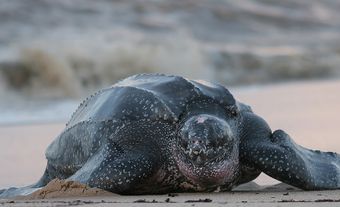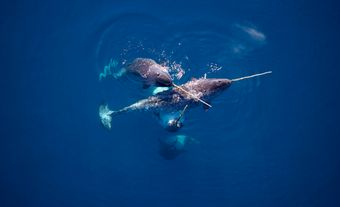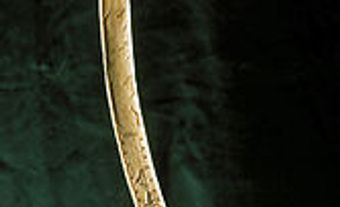The bowhead whale (Balaena mysticetus) is a large baleen whale living in Arctic waters. Two populations are found in Canada: the Bering-Chukchi-Beaufort Sea population and the Eastern Canada-West Greenland population. During the summer, the Bering-Chukchi-Beaufort Sea population is found in the waters of the Yukon and the Northwest Territories, while the Eastern Canada-West Greenland population is found in Davis Strait, Baffin Bay, Lancaster Sound, Hudson Strait, Foxe Basin, northwest Hudson Bay and the channels and fjords of the Arctic Archipelago. Commercial whaling began in the 1500s and ended around 1915. Both populations of bowhead whale were severely reduced by this industry. While their numbers have increased, other challenges, such as climate change and oil and gas development, pose threats to bowhead whales.
Description
The bowhead whale (Balaena mysticetus), or Greenland right whale, is a baleen whale of Arctic seas. It is best known for its long baleen plates, which are specialized feeding tools used in place of teeth, and its sharply bowed upper jaw, which gives the whale its common name.
Bowhead whales are large and stocky animals, with a rounded body and a large head that comprises about a third of the total length. Adults can be over 18 m long and weigh over 60,000 kg. The body is mostly black with white regions including the chin and caudal peduncle (tail stock). Bowhead whales have no dorsal fin.
Distribution and Habitat
The Canadian range includes eastern and western Arctic regions, in two populations: the Bering-Chukchi-Beaufort Sea population is shared with Alaska and the Russian Federation, and occurs in waters of the Yukon and Northwest Territories during summer. The Eastern Canada-West Greenland population also ranges widely and is found in Canadian waters year-round. In summer they occur throughout Davis Strait, Baffin Bay, Lancaster Sound, the channels and fjords of the Arctic Archipelago, Hudson Strait, Foxe Basin, and northwest Hudson Bay. Bowhead whales have a nearly circumpolar distribution, and other populations are found in the Barents and Greenland seas around Svalbard, and the Sea of Okhotsk. Bowheads are the only baleen whale to remain at high latitudes year-round. They are well-adapted to life in ice-covered waters, with a thick blubber layer for warmth and energy storage, and the ability to break through ice over 20 cm thick in order to breathe. Population size in the western Arctic is estimated using photo-identification of individual animals using natural markings, and based on this method, there were more than 10,000 animals in 2001. Numbers in the eastern Canadian Arctic were estimated from aerial surveys in 2002–2003. While imprecise, the surveys indicate a population that currently numbers in the thousands. Both populations have shown recovery after being reduced by commercial whaling.
Diet
Bowhead whales are filter-feeders, eating small animals called zooplankton which they filter out of the water with their baleen. The upper jaw has over 330 baleen plates in each side, which can be over four metres long. Baleen is made of keratin, the same material in human fingernails and hair. To feed, a bowhead whale opens its mouth widely and scoops in large amounts of prey together with large volumes of water. It then partly shuts its mouth and presses its tongue against its upper jaw, forcing the water to pass out through the baleen, and then eating the prey items left behind.
Reproduction and Development
Female bowhead whales become sexually mature and begin to bear calves around age 25, when they are approximately 13 m long. Mating can take place throughout the year, but most occurs in late winter or early spring. Calves are born 12–16 months later, in the following spring or early summer. One calf is born at a time, which is typical of marine mammals. Calves are 4–4.5 m long at birth and grow at a rate of 1.5 cm/day for the first year. The calf is generally nursed for about a year, and most females bear young every 3–4 years.
Relationship with Humans
Both populations have been hunted by humans for centuries. Whales were hunted by Inuit and their Thule ancestors for meat, oil (blubber), muktuk (skin and adhering blubber) and bones. Bowhead whales were extremely important to Thule people for food, fuel and shelter. Large bones like jawbones and ribs provided construction materials for winter houses, an important adaptation to life in a region with little to no driftwood. Baleen and smaller bones were used to make numerous everyday items such as sled runners, harpoons and knife handles.
Commercial whaling started in eastern Canada in the 1500s, followed by the Beaufort-Chukchi-Beaufort region in 1848. Commercial operations in both ended around 1915. Both populations were severely reduced as a result. Whales were killed for their oil and for their baleen (“whalebone”), which was used for making items where flexibility and strength were required, including collar stiffeners, buggy whips, parasol ribs and corset stays. Synthetic materials like plastic and fibreglass are now used for similar purposes.
Bowhead numbers have increased since they were first protected from commercial whaling in 1931, though some whales from both populations are currently hunted for subsistence purposes by Indigenous peoples in Alaska, Chukotka (Russia), Canada and West Greenland. Catch limits are carefully set by governmental or intergovernmental bodies.
Challenges
Bowhead whales can be affected by a range of human activities, including noise disturbance from shipping and offshore oil and gas development, injury or death from collisions with vessels, and entanglement in fishing gear. Reductions in Arctic sea ice due to climate change may result in greater exposure to human activities and may also provide killer whales with increased access to bowhead habitats, increasing predation.
The International Union for Conservation of Nature lists the bowhead whale as “least concern” while the Committee on the Status of Endangered Wildlife in Canada has assessed both populations in Canadian waters as “special concern.” (See also Endangered Animals.)

 Share on Facebook
Share on Facebook Share on X
Share on X Share by Email
Share by Email Share on Google Classroom
Share on Google Classroom






